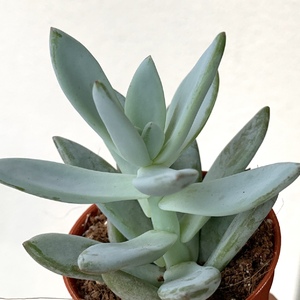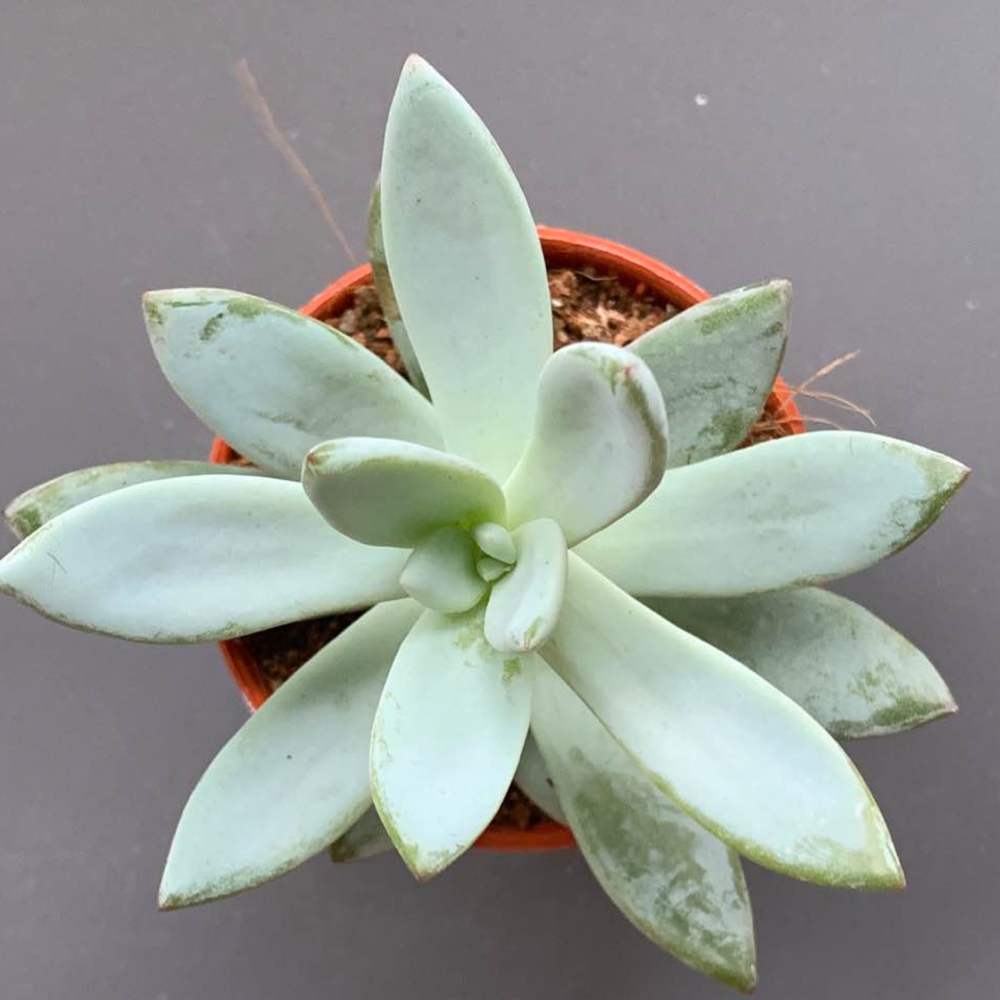植物经验
详细说明
x Pachyveria ‘Powder Puff’ is a beautiful, hybrid succulent (between Pachyphytum oviferum and Echeveria cante) up to 6 inches (15 cm) tall, with powdery, silvery-blue leaves that blush violet in strong light or cold temperatures. Plants have semi decumbent stems terminating in rosettes. It forms arching raceme of small, bell-shaped, apricot flowers during summer months. Great for cascading in rock gardens or as hanging basket.
Pachyphytum will not tolerate frosts well. Temperatures below 20 °F (-6 °C) will kill the plant, and temperatures which may go below 45 °F (7 °C) during extended period should be avoided. Pachyphytum tolerates high heat and intense sunlight. As with most Crassulaceae, Pachyphytum can tolerate (and even appreciated) poor soil conditions, so long as it is well draining. Pachyphytum can thrive in full or partial sunlight.
Allow the soil to dry out before watering, and be careful to avoid getting water on the leaves. In winter, the plants will require more water, as winter begins its active growth season. If you are unsure when to water your Pachyphytum, watch the lower most leaves for signs of drying and water them then. Pachyphytum is FAR more likely to survive under-watering than over-watering. The thick fleshy leaves will appear wilted and a bit “under-full” when they need water.
Leaf cutting entails cutting a young leaf from near the center of the rosette. Leave the leaf out in the open air for a day to allow the wound to callous over.
Growing Conditions
Pachyphytum will not tolerate frosts well. Temperatures below 20 °F (-6 °C) will kill the plant, and temperatures which may go below 45 °F (7 °C) during extended period should be avoided. Pachyphytum tolerates high heat and intense sunlight. As with most Crassulaceae, Pachyphytum can tolerate (and even appreciated) poor soil conditions, so long as it is well draining. Pachyphytum can thrive in full or partial sunlight.
Allow the soil to dry out before watering, and be careful to avoid getting water on the leaves. In winter, the plants will require more water, as winter begins its active growth season. If you are unsure when to water your Pachyphytum, watch the lower most leaves for signs of drying and water them then. Pachyphytum is FAR more likely to survive under-watering than over-watering. The thick fleshy leaves will appear wilted and a bit “under-full” when they need water.
Propagation
Leaf cutting entails cutting a young leaf from near the center of the rosette. Leave the leaf out in the open air for a day to allow the wound to callous over. Dip the leaf into rooting hormone and place the leaf (cut-side down) into slightly moist succulent mix potting soil (even better is very lightly moist sand). Soon, a new rosette will grow from the base of the leaf. As soon as enough roots are present to repot, remove the original leaf cutting and repot the rosette.
General Care
No pruning is necessary except to remove any leaves which have died. This will help to avoid rot and bugs. Avoid touching the healthy leaves of the plant, as your body oils will leave marks.
Whether grown outdoors or in, these plants are good to forget about. Too much attention by nervous gardeners will kill the plant. When grown outdoors in a wet environment, make sure that the soil is sandy and well-draining. If you aren’t careful, your plant will turn to rotten mush. When grown indoors, a standard commercial cactus and succulent soil mixture works well.
Pests and Problems
One of the most common pests to houseplants is the mealybug, and your Pachyphytum may fall prey to this pest. The symptoms of a mealybug infestation is slowed or stopped growth (though in summer this is a normal sign of dormancy). If this occurs without apparent cause, remove the plant from the pot and examine the roots or look at the leaf-stem junctions. A white cottony substance is a sure sign of mealybug infestation. Remove all soil and wash the roots gently. Dab the cottony spots with a q-tip dipped in rubbing alchohol. Remove any roots which appear damaged with a sharp sterile knife or scissors. Let them dry very throroughly before replanting.
In the event of an unhealthy plant, the first thing to examine is your watering habits. The most common problem is root rot due to overwatering. If the soil is too wet, don’t hope it will safely dry out so long as you don’t water it for a while. Replace the soil immediately, but be very careful in handling your Pachyphytum, it’s leaves are very sensitive.
Pachyphytum will not tolerate frosts well. Temperatures below 20 °F (-6 °C) will kill the plant, and temperatures which may go below 45 °F (7 °C) during extended period should be avoided. Pachyphytum tolerates high heat and intense sunlight. As with most Crassulaceae, Pachyphytum can tolerate (and even appreciated) poor soil conditions, so long as it is well draining. Pachyphytum can thrive in full or partial sunlight.
Allow the soil to dry out before watering, and be careful to avoid getting water on the leaves. In winter, the plants will require more water, as winter begins its active growth season. If you are unsure when to water your Pachyphytum, watch the lower most leaves for signs of drying and water them then. Pachyphytum is FAR more likely to survive under-watering than over-watering. The thick fleshy leaves will appear wilted and a bit “under-full” when they need water.
Leaf cutting entails cutting a young leaf from near the center of the rosette. Leave the leaf out in the open air for a day to allow the wound to callous over.
Growing Conditions
Pachyphytum will not tolerate frosts well. Temperatures below 20 °F (-6 °C) will kill the plant, and temperatures which may go below 45 °F (7 °C) during extended period should be avoided. Pachyphytum tolerates high heat and intense sunlight. As with most Crassulaceae, Pachyphytum can tolerate (and even appreciated) poor soil conditions, so long as it is well draining. Pachyphytum can thrive in full or partial sunlight.
Allow the soil to dry out before watering, and be careful to avoid getting water on the leaves. In winter, the plants will require more water, as winter begins its active growth season. If you are unsure when to water your Pachyphytum, watch the lower most leaves for signs of drying and water them then. Pachyphytum is FAR more likely to survive under-watering than over-watering. The thick fleshy leaves will appear wilted and a bit “under-full” when they need water.
Propagation
Leaf cutting entails cutting a young leaf from near the center of the rosette. Leave the leaf out in the open air for a day to allow the wound to callous over. Dip the leaf into rooting hormone and place the leaf (cut-side down) into slightly moist succulent mix potting soil (even better is very lightly moist sand). Soon, a new rosette will grow from the base of the leaf. As soon as enough roots are present to repot, remove the original leaf cutting and repot the rosette.
General Care
No pruning is necessary except to remove any leaves which have died. This will help to avoid rot and bugs. Avoid touching the healthy leaves of the plant, as your body oils will leave marks.
Whether grown outdoors or in, these plants are good to forget about. Too much attention by nervous gardeners will kill the plant. When grown outdoors in a wet environment, make sure that the soil is sandy and well-draining. If you aren’t careful, your plant will turn to rotten mush. When grown indoors, a standard commercial cactus and succulent soil mixture works well.
Pests and Problems
One of the most common pests to houseplants is the mealybug, and your Pachyphytum may fall prey to this pest. The symptoms of a mealybug infestation is slowed or stopped growth (though in summer this is a normal sign of dormancy). If this occurs without apparent cause, remove the plant from the pot and examine the roots or look at the leaf-stem junctions. A white cottony substance is a sure sign of mealybug infestation. Remove all soil and wash the roots gently. Dab the cottony spots with a q-tip dipped in rubbing alchohol. Remove any roots which appear damaged with a sharp sterile knife or scissors. Let them dry very throroughly before replanting.
In the event of an unhealthy plant, the first thing to examine is your watering habits. The most common problem is root rot due to overwatering. If the soil is too wet, don’t hope it will safely dry out so long as you don’t water it for a while. Replace the soil immediately, but be very careful in handling your Pachyphytum, it’s leaves are very sensitive.
花相册 (2)


kensong
2018年11月19日

This is my first growing diary. From C&O RM6.50









